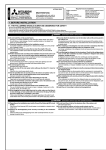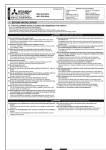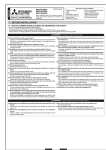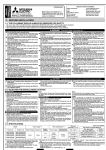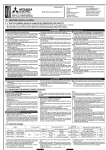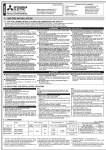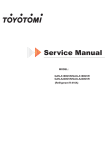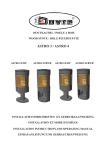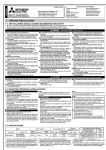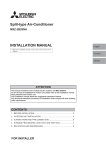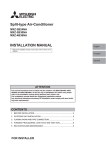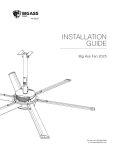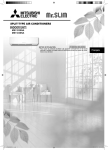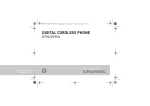Download Mitsubishi Electronics SPLIT-TYPE MSZ-D30/36NA User's Manual
Transcript
ENGLISH JG79A061H01 SPLIT-TYPE AIR CONDITIONERS INSTALLATION MANUAL MSZ-D30/36NA MSY-D30/36NA Required Tools for Installation Phillips screwdriver 5/32 in. (4 mm) hexagonal Level wrench Scale Flare tool for R410A Utility knife or scissors Gauge manifold for R410A 3 in. (75 mm) hole saw Vacuum pump for R410A Torque wrench Charge hose for R410A Wrench (or spanner) Pipe cutter with reamer 1. BEFORE INSTALLATION 1-1. THE FOLLOWING SHOULD ALWAYS BE OBSERVED FOR SAFETY • • • Be sure to read these safety precautions and instructions. %HVXUHWRREVHUYHWKHZDUQLQJVDQGFDXWLRQVVSHFL¿HGKHUH After reading this manual, be sure to store it with the OPERATING INSTRUCTIONS for future reference. Please report to your supply authority or obtain their consent before connecting this equipment to the power supply system. WARNING N Do not install the unit by yourself (user). ,PSURSHURULQFRPSOHWHLQVWDOODWLRQFRXOGFDXVH¿UHHOHFWULFVKRFNLQMXU\GXHWR WKHXQLWIDOOLQJRUZDWHUOHDNDJH&RQVXOWDTXDOL¿HGLQVWDOOHURUWKHGHDOHUIURP whom you purchased the unit. N Follow the instructions detailed in the installation manual. ,QFRPSOHWHLQVWDOODWLRQFRXOGFDXVH¿UHRUHOHFWULFVKRFNLQMXU\GXHWRWKHXQLWIDOOing, or leakage of water. N Install the unit securely in a place that can bear the weight of the unit. If the installation location cannot bear the weight of the unit, the unit could fall causing injury. N Perform electrical work according to the installation manual and be sure to use an exclusive circuit. Do not connect other electrical appliances to the circuit. ,IWKHFDSDFLW\RIWKHSRZHUFLUFXLWLVLQVXI¿FLHQWRUWKHUHLVLQFRPSOHWHHOHFWULFDO ZRUNLWFRXOGUHVXOWLQD¿UHRUDQHOHFWULFVKRFN N Ground the unit correctly. Do not connect the ground wire to a gas pipe, water pipe, lightning rod or telephone ground. Defective grounding could cause electric shock. N Do not damage the wires. 'DPDJHGZLUHVFRXOGFDXVH¿UH N Be sure to shut off the main power when setting up the indoor P.C. board or wiring. Failure to do so could cause electric shock. N 8VHWKHVSHFL¿HGZLUHVWRVHFXUHO\FRQQHFWWKHLQGRRUDQGRXWGRRUXQLWV$WWDFKWKHZLUHV¿UPO\WRDYRLGDSSO\LQJVWUHVVWRWKHWHUPLQDOEORFN ,PSURSHUFRQQHFWLRQFRXOGFDXVH¿UH N 'RQRWLQVWDOOWKHXQLWLQDSODFHZKHUHÀDPPDEOHJDVPD\OHDN If gas leaks and accumulates around the unit, it could cause an explosion. N Do not use intermediate connection of the power cord or the extension cord. Do not connect many devices to one AC outlet. ,WFRXOGFDXVHD¿UHRUDQHOHFWULFVKRFN N 8VHWKHSDUWVSURYLGHGRUVSHFL¿HGSDUWVIRUWKHLQVWDOODWLRQZRUN 7KHXVHRIGHIHFWLYHSDUWVFRXOGFDXVHDQLQMXU\RUOHDNDJHRIZDWHUGXHWRD¿UH an electric shock, the unit falling, etc. N When plugging the power supply plug into the outlet, make sure that there is no dust, blockage, or loose parts both in the outlet and on the plug. Verify that the power supply plug is completely in the outlet. If there is dust, blockage, or loose parts on the power supply plug or the outlet, it could FDXVHHOHFWULFVKRFNRU¿UH,IORRVHSDUWVDUHIRXQGRQWKHSRZHUVXSSO\SOXJUHSODFHLW (Could lead to death or serious injury.) N Securely attach the electrical cover to the indoor unit and the service panel to the outdoor unit. If the electrical cover of the indoor unit and/or the service panel of the outdoor unit are QRWDWWDFKHGVHFXUHO\GXVWZDWHUHWFFRXOGFROOHFWLQWKHXQLWDQGFRXOGFDXVHD¿UHRU an electric shock. N When installing or relocating the unit, make sure that no substance other than WKHVSHFL¿HGUHIULJHUDQW5$HQWHUVWKHUHIULJHUDQWFLUFXLW Any foreign substances in the refrigerant circuit can cause abnormal pressure rise or an explosion. N Do not discharge the refrigerant into the atmosphere. Check that the refrigerant gas does not leak after installation has been completed. If refrigerant leaks during installation, ventilate the room. ,IUHIULJHUDQWFRPHVLQFRQWDFWZLWKD¿UHKDUPIXOJDVFRXOGEHJHQHUDWHG ,IUHIULJHUDQWJDVOHDNVLQGRRUVDQGFRPHVLQWRFRQWDFWZLWKWKHÀDPHRIDIDQ heater, space heater, stove, etc., harmful gases will be generated. N Use appropriate tools and piping materials for installation. The pressure of R410A is 1.6 times higher than R22. Not using the appropriate tools and materials, or improper installation could cause the pipes to burst causing an injury. N When pumping down the refrigerant, stop the compressor before disconnecting the refrigerant pipes. If the refrigerant pipes are disconnected while the compressor is running and the stop valve is open, air could be drawn in and the pressure in the refrigeration cycle could become abnormally high, causing the pipes to burst. N When installing the unit, securely connect the refrigerant pipes before starting the compressor. If the compressor is started before the refrigerant pipes are connected and the stop valve is open, air could be drawn in and the pressure in the refrigeration cycle could become abnormally high, causing the pipes to burst. N )DVWHQDÀDUHQXWZLWKDWRUTXHZUHQFKDVVSHFL¿HGLQWKLVPDQXDO ,IIDVWHQHGWRRWLJKWDÀDUHQXWFRXOGEUHDNDQGFDXVHUHIULJHUDQWOHDNDJH N Install the unit according to national wiring regulations. CAUTION (Could lead to serious injury when operated incorrectly.) N Depending on the installation area, install a Ground Fault Interrupt (GFI) circuit breaker. If the Ground Fault Interrupt (GFI) circuit breaker is not installed, an electric shock could occur. N Perform the drainage/piping work securely according to the installation manual. If there is defect in the drainage/piping work, water could drip from the unit, and damage household items. N 'RQRWWRXFKWKHDLULQOHWRUWKHDOXPLQXP¿QVRIWKHRXWGRRUXQLW This could cause injury. N Do not install the outdoor unit where small animals may live. If small animals enter the unit and damage its electrical parts, it could cause a PDOIXQFWLRQVPRNHHPLVVLRQRU¿UH.HHSWKHDUHDDURXQGWKHXQLWFOHDQ 1-2. SELECTING THE INSTALLATION LOCATION INDOOR UNIT :KHUHDLUÀRZLVQRWEORFNHG • Where cool air aspreads over the entire room. • On a rigid wall to reduce the possibility of vibration. • Where it is not exposed to direct sunlight. • Where it can be easily drained. • At a distance 3 ft. (1 m) or more away from a TV and radio. Operation of the air conditioner may interfere with radio or TV reception. An amplifier may be required for the affected device. • In a place as far away as possible from fluorescent and incandescent lights (so the infrared remote control can operate the air conditioner normally). • :KHUHWKHDLU¿OWHUFDQEHUHPRYHGDQGUHSODFHGHDVLO\ Note: Install the indoor unit high on the wall where air can distribute over the entire room. REMOTE CONTROLLER • Where it is convenient to operate and easily visible. • Where children cannot easily touch it. 6HOHFWDSRVLWLRQDERXWIWPDERYHWKHÀRRU Check that signals from the remote controller from that position are received by the indoor unit (‘beep’ or ‘beep beep’ receiving tone sounds). Then, attach remote controller holder to a pillar or wall and install wireless remote controller. Note: Note: ,QURRPVZKHUHLQYHUWHUW\SHÀXRUHVFHQWODPSVDUHXVHG • It is advisable to make a piping loop near outdoor unit the signal from the wireless remote controller may not be so as to reduce vibration. received. )RU LQFUHDVHG HI¿FLHQF\ LQVWDOO WKH RXWGRRU XQLW LQ D location where continuous direct sunlight or excessive OUTDOOR UNIT water can be avoided as much as possible. • Where it is not overly exposed to strong winds. :KHUHDLUÀRZLVJRRGDQGGXVWOHVV • Where neighbours are not annoyed by operation Note: sound or hot air. When operating the air conditioner in low outside tem• Where rigid wall or support is available to prevent the perature, be sure to follow the instructions described increase of operation sound or vibration. below. • Where there is no risk of combustible gas leakage. • Never install the outdoor unit in a place where its air • If installing the unit in a location high above the ground, inlet/outlet side may be exposed directly to wind. be sure to secure the unit legs. • To prevent exposure to wind, install the outdoor • Where it is at least 10 ft. (3 m) away from the antenna unit with its air inlet side facing the wall and DEDIÀH of TV set or radio. Operation of the air conditioner may board on the air outlet side. interfere with radio or TV reception in areas where reAvoid the following places for installation where air FHSWLRQ LV ZHDN $Q DPSOL¿HU PD\ EH UHTXLUHG IRU WKH conditioner trouble is liable to occur. affected device. :KHUHÀDPPDEOHJDVFRXOGOHDN • Install the unit horizontally. • Where there is an excessive amount of machine oil • Please install it in an area not affected by snowfall or in the air. blowing snow. In areas with heavy snow, please install • Salty places such as the seaside. DFDQRS\DSHGHVWDODQGRUEDIÀHERDUGV • Where sulfide gas is generated such as a hot spring. • Where there is high-frequency or wireless equipment. 1-3. SPECIFICATIONS (OHFWULFDOVSHFL¿FDWLRQV 1-3-1. POWER SUPPLY AND INDOOR/OUTDOOR WIRE CONNECTION • • • • Power should be taken from an exclusive branched circuit. Wiring work should be based on applicable technical standards. Wiring connections should be made following the diagram. Securely tighten screws. Connecting wires and the ground wire • Use solid conductor AWG14 or stranded conductor AWG14. • Use double insulated copper wire with 600 V insulation. • Use copper conductors only. * Follow local electrical codes. Power supply cable and ground wire • Use solid or stranded conductor AWG12. • Use copper conductors only. * Follow local electrical codes. Note: When the indoor unit is powered from the outdoor unit, depending on local code, a disconnect switch needs to be installed to a power supply circuit. MODEL MSY-D30NA MSY-D36NA MSZ-D30NA MSZ-D36NA INDOOR UNIT Power supply (V, PHASE, Hz) 208/230, 1, 60 Min. Circuit Ampacity (A) 1.0 Fan motor (F.L.A.) 0.76 (A) OUTDOOR UNIT Power supply (V, PHASE, Hz) 208/230, 1, 60 Max. Fuse size (time delay) (A) 25 Min. Circuit Ampacity (A) 21 Fan motor (F.L.A.) (A) 0.93 (R.L.A) (A) 16 Compressor (L.R.A) (A) 20 Indoor unit - Remote controller: (Wireless) Indoor unit - Outdoor unit: DC12-24 V (Polar) Control voltage 1-3-2. REFRIGERANT PIPES • To prevent condensation, insulate the two refrigerant pipes. • Refrigerant pipe bending radius must be 4 in. (100 mm) or more. Pipe CAUTION %HVXUHWRXVHWKHLQVXODWLRQRIVSHFL¿HGWKLFNQHVVWDEOHRQWKHULJKW([FHVVLYHLQVXODtion may cause incorrect installation of the indoor unit, and too little insulation may cause condensate to form. • • • 7KHXQLWKDVÀDUHGFRQQHFWLRQVRQERWKLQGRRUDQGRXWGRRUVLGHV Remove the valve cover from the outdoor unit, then connect the pipe. Refrigerant pipes are used to connect the indoor and outdoor units. Be careful not to crush or over bend the pipe in pipe bending. Insulation thickness Insulation material inch (mm) For liquid 3/8 (9.52) 0.0315 (0.8) 5/16 (8) For gas 5/8 (15.88) 0.0394 (1.0) 5/16 (8) Heat resistant foam SODVWLF6SHFL¿F gravity Limits Pipe length 100 ft. (30 m) max. Height difference 50 ft. (15 m) max. No. of bends • Refrigerant adjustment... If pipe length exceeds 25 ft. (7.5 m), additional refrigerant (R410A) charge is required. (The outdoor unit is charged with refrigerant for pipe length up to 25 ft. [7.5 m]) Minimum wall thickness Outside diameter 10 max. Up to 25 ft. (7.5 m) No additional charge is required. Exceeding 25 ft. (7.5 m) Additional charge is required. (Refer to the table below.) Pipe length MSZ-D30/36NA 2.96 oz. each 5 ft. (55 g/m) MSY-D30/36NA 1.08 oz. each 5 ft. (20 g/m) Refrigerant to be added 1-4. INSTALLATION DIAGRAM Use the wall hole sleeve (C) to prevent indoor/outdoor connecting wire (A) from contacting metal parts in the wall and to protect the wiring from rodents. 1 Attachment screws for the installa(2) tion plate 4 × 25 mm 7 (3) Remote controller holder 1 Screws for the remote controller (4) holder 3.5 × 16 mm (Black) 2 (5) Battery (AAA) for (6) 2 (6) Wireless remote controller 1 Felt tape (7) (For left or left-rear piping) 2 (8) $LUFOHDQLQJ¿OWHU 2 (9) Charge nut 1 (10) L-joint 1 Seal the wall hole gap with putty (H). Wall hole sleeve (C) Cut off the extra length. Pipe attachment strap (E) 4-11/1 (120 m6 in. m) or more Attachment screw (F) 8-11/1 (220 m6 in. or mo m) re After the leak test, apply insulating material tightly so that there is no gap. Space for indoor unit working Please leave the space as shown in the picture for maintenance usage. 4 in. (100 mm) or more FIELD-SUPPLIED PARTS (B) Extension pipe 1 (C) Wall hole sleeve 1 (D) Wall hole cover 1 (E) Pipe attachment strap 2 to 5 (F) Screw for (E) 4 × 20 mm 2 to 5 (G) Piping tape 1 (H) Putty 1 (I) Drain hose (or soft PVC hose, 19/32 in. [15 mm] inner diameter or hard PVC pipe VP16) 1 (J) Refrigerant oil 1 (K) Power supply cord * 1 * Note: Place indoor/outdoor unit connecting wire (A) and power supply cord (K) at least 3 ft. (1 m) away from the TV antenna wire. Note: Do not obstruct the air outlet. Space When the piping is to be attached to a wall comprised of tin plate or metal netting, use chemically treated wooden piece 25/32 in. (20 mm) or thicker between the wall and the piping, or wrap insulation vinyl tape 7 to 8 turns around the piping. To use existing piping, perform COOL operation for 30 minutes and pump down before removing the old air conditioner. 5HPDNHÀDUHDFFRUGLQJWRWKHGLPHQVLRQ for new refrigerant. 20 in. (500 mm) or more Outdoor unit installation Unit: inch 33-1/16 3-15/16 19-11/16 . 4 inmm) 0 re (10r mo o (10 4 in. 0m or m orem) Air inlet 14-3/16 1 Installation plate 15-14/32 13 Indoor/outdoor unit connecting wire * 5/16 in. (7 mm) or more Indoor unit (A) Attach the pipe to wall with pipe attachment strap (E). 9-27/32 in. (250 mm) or more (1) Installation plate 2-13/16 in. (70 mm) or more/ 5-1/8 in. (130 mm) or more for left and left back piping (using spacer) ACCESSORIES Check the following parts before installation. <Indoor unit> Wall hole cover (D) Indoor unit Air outlet 4-3/8 x 13/16 slot in. ) 20 mme 0 r (50r mo o 1-18/32 (3514 in 0m. or m orem) Unit: mm 840 100 500 360 392 330 Air inlet Air outlet 4-10 x 21 slot Units should be installed by licensed contractor according to local code requirements. 40 2. INDOOR UNIT INSTALLATION 2-1. ATTACHING THE INSTALLATION PLATE 2-13/16 in. (70 mm) or more 5-1/8 in. (130 mm) or more for left and left back piping (using spacer) Ceiling • Find a stud in the wall to attach installation plate (1) horizontally on the wall with screws (2). • To prevent installation plate (1) from vibrating, be sure to install the attachment screws in the holes indicated in the illustration. For added support, additional screws may also be installed in other holes. ,IWKHUHFHVVHGEROWLVWRRORQJFKDQJHLWIRUDVKRUWHURQH¿HOGVXSSOLHG Installation plate (1) Wall Level 4 in. (100 mm) 4-11/16 in. (120 mm) or more Insert the scale. * Attachment screw (2) Align the scale with the line. * 8-11/16 in. (220 mm) Wall or more Center of ø 3 in. (75 mm) hole * Same for left hole. 2-2. DRILLING Wall 1) Determine where the holes will be located on the wall. 2) Drill a ø 3 in. (75 mm) hole. The outdoor side should be 6/32 to 9/32 in. (5 to 7 mm) lower than the indoor side. 3) Insert wall hole sleeve (C). ø 3 in. (75 mm) 6/32-9/32 in. (5-7 mm) Outdoor side 2-3. CONNECTING WIRES FOR INDOOR UNIT Note: When the indoor unit is powered from the outdoor unit, depending on local code, a disconnect switch needs to be installed to a power supply circuit. Electrical cover Pull tab to remove cable guide. VA Clamp 1) 2) 3) 4) 5) 6) 7) 8) Open the front panel. Place the upper part of the indoor unit on the installation plate. Remove electrical cover. Remove VA clamp. Remove corner box. Remove cable guide. Remove conduit plate. Attach conduit pipe (for rear piping) / elbow joint (for right, left, or downward piping) to conduit plate with lock nut. The thread of the installed conduit pipe / elbow joint appearing inside should be less than 3/8 in. (10 mm). (Fig. 1) Elbow joint should appear less than 1-3/16 in. (30 mm) outside. (Fig. 2) 9) Process the end of ground wire (Fig. 3). Connect it to the ground terminal of electrical parts box. 10) Process the end of indoor/outdoor unit connecting wire (A) (Fig.3). Attach it to the terminal block. Be careful not to make mis-wiring. Attach the wire to the terminal block securely so that its core cannot be seen, and no external force affects the connecting section of the terminal block. 11) Firmly tighten the terminal screws. After tightening, verify that the wires are tightly fastened. 12) Reinstall conduit plate. 13) Reinstall cable guide. 14) According to the piping direction, remove the shaded part of the left side of box (Fig.4) or corner box (Fig. 5). 15) Reinstall VA clamp. 16) Reinstall electrical cover. 17) Reinstall panel assembly. Electrical box Indoor terminal block Grounding terminal Cable guide Conduit pipe Conduit plate or Lock nut • Connect wires to the appropriate terminals • For future servicing, leave some slack in the connecting wires. Elbow joint Conduit plate Remark: * A disconnect switch is required. Check the local code. ** Use a ring tongue terminal in order to connect a ground wire to terminal. INDOOR UNIT Terminal block Less than 3/8 in. (10 mm) Grounding terminal** Lock nut Conduit pipe or elbow joint Disconnect switch* Fig. 1 208/230 V AC 1phase, 60 Hz 2-3/16 in. (55 mm) Less than 1-3/16 in. (30 mm) Elbow joint (for right, left, or downward piping) Fig. 2 5/8 in. (15 mm) Terminal block 1 OUTDOOR UNIT Conduit plate Power supply 208/230 V AC, 1phase 2 wires, 60 Hz Lead wire Box • Make ground wire a little longer than Remove panel for piping on Remove panel for piping others. (More than 1-9/16 in. [40 mm]) Fig. 3 Ground Grounding terminal** Corner box Remove panel for piping on bottom side of unit Remove panel for piping on right side of unit Fig. 5 left side of unit on bottom left side of unit Fig. 4 2-4. INSTALLING THE L-JOINT 1) Install L-joint (10) on the back of the unit. Position L-joint (10) according to the piping direction. (Fig. 1) In case of bottom piping (Fig. 2) • Cut L-joint (10) at the position shown in Fig. 3. • Remove union nut from the unit and install it to L-joint (10). • Flare end of L-joint (10). 2) Use two torque wrenches to tighten the nut. (tighten torque 65 N•m) (Fig. 4) 3) Install charge nut (9) to the liquid refrigerant piping, which connects the indoor and outdoor unit. 4) Perform leak test of joint part (the part tightened in “2)”), the nut on the gas side should remain installed. 5) Slide pipe cover of L-joint (10) and cover the joint. (Fig. 5) Remove panel for piping on right side of unit Remove panel for piping on bottom right side of unit Fig. 1 Fig. 2 Cut Fig. 3 Tightening direction Slide the pipe cover completely to the end. Fig. 4 Fig. 5 2-5. PIPE FORMING AND DRAIN PIPING 2-5-1. PIPE FORMING • • • Place the drain hose below the refrigerant piping. Make sure that the drain hose is not crowded or bent. Do not pull the hose when applying the tape. :KHQWKHGUDLQKRVHSDVVHVWKHURRPEHVXUHWRZUDSLWZLWKLQVXODWLRQPDWHULDO¿HOG supplied). Note: Make sure not to damage the cover of refrigerant pipe when attaching it back on with screws. Left or left-rear piping Note: Be sure to reattach the drain hose and the drain cap if the piping is being installed on left or bottom left of unit, otherwise, water could drip down from the drain hose. 3ODFHWKHUHIULJHUDQWSLSLQJDQGWKHGUDLQKRVHWRJHWKHUWKHQ¿UPO\DSSO\IHOWWDSH from the end. Felt tape (7) overlap width should be 1/3 the tape width. Use a bandage stopper at the end of felt tape (7). 2) Pull out the drain cap at the back right of the indoor unit. (Fig. 1) • Hold the convex section at the end and pull the drain cap. 3) Pull out the drain hose at the back left of the indoor unit. (Fig. 2) • Hold the claw marked by the arrows and pull out the drain hose forward. 4) Put the drain cap into the section to which the drain hose is to be attached at the rear of the indoor unit. (Fig. 3) • Insert a screwdriver into the hole on the cap and insert the cap fully into the drain pan. 5) Insert the drain hose fully into the drain pan at the back right of the indoor unit. (Fig. 4) • Check if the hose is hooked securely to the projection of its inserting part at the drain pan. 6) Insert the drain hose into wall hole sleeve (C), and attach the upper part of indoor unit onto the installation plate (1). Then, shift the indoor unit completely to the left to make placing the piping in the back of the unit easier. 7) Cut out two pieces of cardboard from the shipping box (use any two pieces of the four pieces), roll each piece, hook them onto the back rib, and use them as spacer to lift the indoor unit. (Fig. 5) 8) Connect the refrigerant piping with the extension pipe (B). 9) Attach the lower part of the indoor unit into the installation plate (1). Liquid pipe Gas pipe Indoor/outdoor unit connecting wire (A) Felt tape (7) Piping tape (G) Piping tape (G) Remove panel for piping on left side of unit. Felt tape (7) Drain cap Fig. 1 Drain hose Fig. 2 Drain hose Drain cap Fig. 3 Fig. 4 Fig. 5 Rear or bottom piping 3ODFHWKHUHIULJHUDQWSLSLQJDQGWKHGUDLQKRVHWRJHWKHUWKHQ¿UPO\DSSO\SLSLQJWDSH* from the end. 2) Insert the piping and the drain hose into the wall hole sleeve (C), and attach the upper part of the indoor unit on the installation plate (1). 3) Check if the indoor unit is attached securely on the installation plate (1) by moving the unit to left and right. 4) Attach the lower part of the indoor unit into the installation plate (1). Cut off in case of downward piping. Right piping Note: Before performing the following, make sure that wiring is completed, and the conduit cover is installed. (Refer to 2-3.) 1) Place the refrigerant piping and the drain hose together, shift them to left side of the XQLWDQGWKHQ¿UPO\DSSO\SLSLQJWDSH*IURPWKHHQG 2) Insert the piping and the drain hose into the wall hole sleeve (C), and attach the upper part of the indoor unit on the installation plate (1). 3) Check if the indoor unit is attached securely on the installation plate (1) by moving the unit to left and right. 4) Attach the lower part of the indoor unit into the installation plate (1). 2-5-2. DRAIN PIPING Drain hose Drain hose • If the extension drain hose has to pass through a room, be sure to wrap it with inVXODWLRQ¿HOGVXSSOLHG • The drain hose should point downward for easy drain. (Fig. 1) ,IWKHGUDLQKRVHSURYLGHGZLWKWKHLQGRRUXQLWLVWRRVKRUWFRQQHFWLWZLWKD¿HOG supplied drain hose (I). (Fig. 2) • When connecting the drain hose to a hard vinyl chloride pipe, be sure to insert it securely into the pipe. (Fig. 3) Downward slope Soft hose I.D. 19/32 in. (15 mm) Fig. 1 27-9/16 in. (70 cm) or more Different diameter joint Fig. 2 Hard vinyl chloride pipe I.D. 1-3/16 in. (30 mm) Insert securely Fig. 3 Do not make drain piping as shown below. Accumulated drain water Do not raise Tip of drain hose dipped in water Air Water leakage Water leakage Water leakage Waving At least 1-31/32 in. (50 mm) gap Ditch 3. OUTDOOR UNIT INSTALLATION 3-1. CONNECTING WIRES FOR OUTDOOR UNIT 1) Remove the service panel. 2) Remove the conduit cover. 3) Attach the conduit connector to conduit cover with lock nut then secure it against unit with screws. 4) Connect ground wires of indoor/outdoor unit connecting wire (A) and power supply cord (K) to the TB support. 5) Loosen the terminal screw, and attach indoor/outdoor unit connecting wire (A) from the indoor unit correctly on the terminal block. Attach the wire to the terminal block securely so that its core cannot be seen, and no external force affects the connecting section of the terminal block. 6) Firmly tighten the terminal screws. After tightening, verify that the wires are tightly fastened. 7) Connect power supply cord (K). 8) Install the conduit cover. 9) Install the service panel securely. Service panel 5/8 in. (15 mm) 1-3/8 in. (35 mm) Power supply cord (K) Lead wire Lock nut Conduit cover Connector Terminal block Power supply cord (K) Indoor/outdoor unit connecting wire (A) to conduit cover Grounding terminal TB support • Make ground wire a little longer than others. (More than 1-3/8 in. [35 mm]) • For future servicing, leave some slack in the connecting wires. A inch (mm) Pipe diameter inch (mm) Nut inch (mm) ø 1/4 (6.35) 1/4 (17) ø 3/8 (9.52) 3/8 (22) Clutch type tool for R410A 0 to 0.02 (0 to 0.5) ø 1/2 (12.7) 1/2 (26) ø 5/8 (15.88) 5/8 (29) Clutch type tool for R22 0.04 to 0.06 (1.0 to 1.5) Tightening torque Wing nut type tool for R22 0.06 to 0.08 (1.5 to 2.0) 0.08 to 0.10 (2.0 to 2.5) N•m ft•lb (kgf•cm) 13.7 to 17.7 10 to 13 (140 to 180) 34.3 to 41.2 25 to 30 (350 to 420) 49.0 to 56.4 36 to 42 (500 to 575) 73.5 to 78.4 54 to 58 (750 to 800) No good Good Copper pipe Tilted Uneven Burred Fig. 1 Fig. 2 Copper pipe Spare reamer Burr Pipe cutter Fig. 3 Flaring tool 3-2. FLARE CONNECTION 1) Cut the copper pipe as straight as possible with a pipe cutter. (Fig. 1, 2) 2) Remove all burrs from the cut section of the pipe, ensuring that precautions are taken to avoid getting metal shavings into the piping. (Fig. 3) 5HPRYHÀDUHQXWVDWWDFKHGWRLQGRRUDQGRXWGRRUXQLWVWKHQSXWWKHPRQSLSH 4) Flaring work (Fig. 4, 5). Firmly hold copper pipe in the dimension shown in the table. Select A mm from the table according to the tool you use. 5) Check &RPSDUHWKHÀDUHGZRUNZLWK)LJ ,IÀDUHLVGHIHFWLYHFXWRIIWKHVHFWLRQDQGUHSHDWSURFHGXUH Copper pipe Die Clutch type Wing nut type Flare nut Fig. 4 Fig. 5 Inside is shining without any scratches. Smooth all around Even length all around Fig. 6 3-3. PIPE CONNECTION )DVWHQÀDUHQXWZLWKDWRUTXHZUHQFKDVVSHFL¿HGLQWKHWDEOHDERYH :KHQIDVWHQHGWRRWLJKWÀDUHQXWPD\HYHQWXDOO\EUHDNDQGFDXVHUHIULJHUDQWOHDNDJH Indoor unit connection Connect both liquid and gas piping to indoor unit. • Apply a thin coat of refrigerant oil (J) on the seat surface of pipe. 7RFRQQHFW¿UVWDOLJQWKHFHQWHUWKHQWLJKWHQWKH¿UVWWRWXUQVRIÀDUHQXW • Use tightening torque table above as a guideline for indoor unit side joints, and tighten XVLQJWZRZUHQFKHV([FHVVLYHWLJKWHQLQJGDPDJHVWKHÀDUHVHFWLRQ Outdoor unit connection Connect pipes to stop valve pipe joint of the outdoor unit following the same procedure detailed in Indoor unit connection. • For tightening, use a torque wrench or spanner. 3-4. INSULATION AND TAPING 1) Cover piping joints with pipe cover. 2) For outdoor unit side, insulate the piping, including valves. 3) Apply piping tape (G) starting from the connection on the outdoor unit. • When piping has to be installed through a ceiling, closet or where the temperature DQGKXPLGLW\DUHKLJKXVHDGGLWLRQDO¿HOGVXSSOLHGLQVXODWLRQWRSUHYHQWFRQGHQVDtion. 4. PURGING PROCEDURES, LEAK TEST, AND TEST RUN 4-1. PURGING PROCEDURES AND LEAK TEST 1) Remove service port cap of stop valve on the side of the outdoor unit gas pipe. 2) Connect gauge manifold valve and vacuum pump to service port of stop valve on the gas pipe side of the outdoor unit. 3) Run the vacuum pump 15 minutes or more. 4) Check the vacuum with the gauge manifold valve, then close it and shut off the vacuum pump. 5) Leave as it is for one or two minutes. Make sure pointer gauge manifold valve remains LQ WKH VDPH SRVLWLRQ &RQ¿UP WKDW SUHVVXUH JDXJH VKRZV ± 03D >*DXJH@ ± LQ+J>±PP+J@ 6) Quickly remove gauge manifold valve from service port of stop valve. 7) After refrigerant pipes are connected and evacuated, fully open all stop valves on both sides of gas pipe and liquid pipe. Operating the unit without fully opening the valves lowers the performance and causes problems. 8) Refer to 1-3. SPECIFICATIONS, and charge the prescribed amount of refrigerant if needed. Be sure to charge slowly with liquid refrigerant. Otherwise, composition of the refrigerant in the system may be changed and affect performance of the air conditioner. 9) Tighten cap of service port. 10) Conduct a leak test *4 to 5 turns Stop valve cap (Torque 19.6 to 29.4 N•m, 200 WRNJIƒFP *Close *Open ±03D ±LQ+J >±PP+J@ Stop valve for LIQUID Handle Low Hexagonal wrench Stop valve for GAS Service port cap (Torque 13.7 to 17.7 N•m, 140 to 180 kgf•cm) Adapter for preventing the back ÀRZ Compound pressure gauge (for R410A) Pressure gauge (for R410A) Gauge manifold valve (for R410A) Handle High Charge hose (for R410A) Vacuum pump (or the vacuum pump with the function to SUHYHQWWKHEDFNÀRZ Precautions when using the control valve When attaching the control valve to the service port, valve core may deform or loosen if excess pressure is applied. This may cause gas leak. Service port A Control valve Open Charge hose Close Body When attaching the control valve to the service port, make sure that the valve core is in closed position, and then tighten part A. Do not tighten part A or turn the body when valve core is in open position. 4-2. TEST RUN 1) Insert power supply plug into the power outlet and/or turn on the breaker. 2) Press the E.O. SW once. Test run will be performed for 30 minutes. If the left operation indicator light blinks every 0.5 seconds, inspect the indoor/outdoor unit connecting wire (A). After the test run, emergency COOL mode (75ºF [24ºC] COOL) will start. 3) To stop operation, press the E.O. SW several times until all LED lamps turn off. Refer to operating instructions for details. Emergency operation switch (E.O. SW) Checking the remote (infrared) signal reception Press the ON/OFF button on the remote controller and listen for an audible indicator from the indoor unit. Press the ON/OFF button again to turn the air conditioner off. • Once the compressor stops, the restart preventive device operates so the compressor will not operate for 3 minutes to protect the air conditioner. 4-3. AUTO RESTART FUNCTION This product is equipped with an auto restart function. When the power supply is cut off during operation, such as during blackouts, the function automatically starts operation in the previous setting once the power supply is resumed. (Refer to the operating instructions for details.) Caution: • After test run or remote signal reception check, turn off the unit with the E.O. SW or the remote controller before turning off the power supply. If this procedure is not performed, the unit will automatically begin operation when power supply is resumed. To the user • After installing the unit, explain to the user about auto restart function. • If auto restart function is unnecessary, it can be deactivated. Consult the service representative to deactivate the function. Refer to the service manual for details. 4-4. EXPLANATION TO THE USER • Using the OPERATING INSTRUCTIONS, explain to the user how to use the DLUFRQGLWLRQHUWKHUHPRWHFRQWUROOHUUHPRYLQJWKHDLU¿OWHUVSODFLQJRUUHPRYing the remote controller from the remote controller holder, cleaning methods, precautions for operation, etc.) • Recommend that the user read the OPERATING INSTRUCTIONS carefully. 5. RELOCATING THE UNIT / MAINTENANCE 5-1. REMOVING AND INSTALLING THE PANEL ASSEMBLY Removal procedure (Fig. 1, 2) 1) Remove the three screws that attach the panel assembly. 2) Open the front panel. 3) Remove the two screws that attach the panel assembly. 5HPRYHWKHSDQHODVVHPEO\%HVXUHWRUHPRYHLWVERWWRPHQG¿UVW Fig. 1 Fig. 2 Installation procedure (Fig. 3, 4) 1) Point the horizontal vane slightly downward. 2) Attach the bottom of the panel assembly under the horizontal vane. 3) Fit in the top of the panel assembly. 4) Fit in the bottom of the panel assembly and tighten it using screws. 5) Push the section of the front panel marked by the arrows to close the front panel securely. Fig. 3 Horizontal vane Fig. 4 5-2. REMOVING THE INDOOR UNIT Remove the bottom of the indoor unit from the installation plate. (Fig. 1, 2) • Remove the panel assembly. (Refer to 5-1) ,QVHUWÀDWVFUHZGULYHUVLQWRWKHVTXDUHKROHVDWWKHOHIWDQGULJKWERWWRPRIWKHLQGRRU unit and push them up; the bottom of the indoor unit goes down and the hooks are released. *1 Remove the screw. *2 Remove the tab of corner box from the indoor unit, and pull the corner box. *3 Pull the indoor unit to remove. Corner box Push Lower Square hole Fig. 1 Fig. 2 5-3. PUMPING DOWN When relocating or disposing of the air conditioner, pump down the system following the procedure below so that refrigerant is not released into the atmosphere. 1) Connect the gauge manifold valve to the service port of the stop valve on the gas pipe side of the outdoor unit. 2) Fully close the stop valve on the liquid pipe side of the outdoor unit. 3) Close the stop valve on the gas pipe side of the outdoor unit almost completely so that it can be easily closed fully when the pressure gauge shows 0 MPa [Gauge] (0 lbf/in.2 [0 kgf/cm2]). 4) Start the emergency COOL operation. To start the emergency operation in COOL mode, disconnect the power supply plug and/or turn off the breaker. After 15 seconds, connect the power supply plug and/or turn on the breaker, and then press the E.O. SW once. (The emergency COOL operation can be performed continuously for up to 30 minutes.) 5) Fully close the stop valve on the gas pipe side of the outdoor unit when the pressure gauge shows 0.05 to 0 MPa [Gauge] (approx. 7.25 to 0 lbf/in2 [0.5 to 0 kgf/cm2]). 6) Stop the emergency COOL operation. To stop operation, press the E.O. SW several times until all LED lamps turn off. Refer to operating instructions for details. HEAD OFFICE: TOKYO BLDG., 2-7-3, MARUNOUCHI, CHIYODA-KU, TOKYO 100-8310, JAPAN








